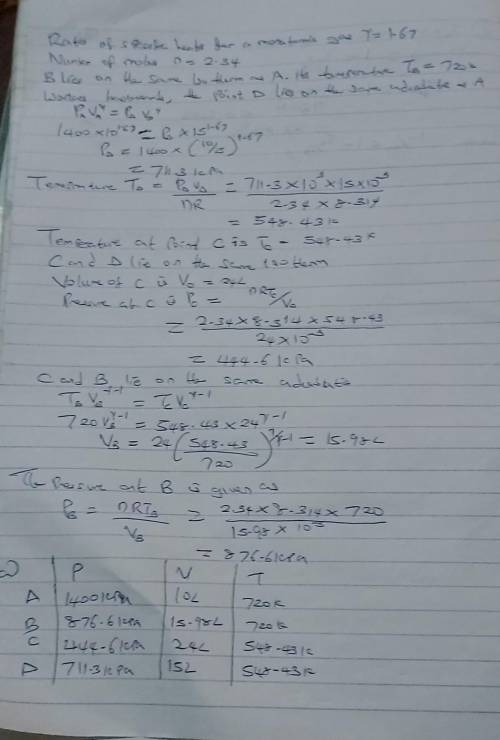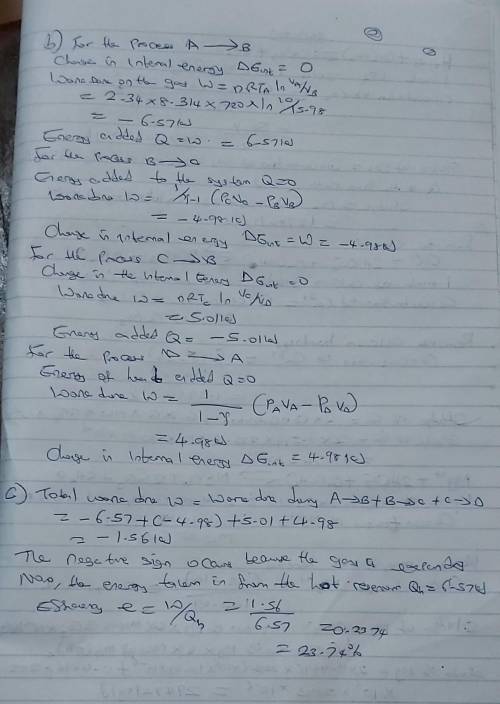
At point A in a Carnot cycle, 2.34 mol of a monatomic ideal gas has a pressure of 1 400 kPa, a volume of 10.0 L, and a temperature of 720 K. The gas expands isothermally to point B and then expands adiabatically to point C, where its volume is 24.0 L. An isothermal compression brings it to point D, where its volume is 15.0 L. An adiabatic process returns the gas to point A. (a) Determine all the unknown pressures, volumes, and temperatures as you fill in the following table. P V T A 1 400 kPa 10.0 L 720 K B C 24 L D 15 L (b) Find the energy added by heat, the work done by the engine, and the change in internal energy for each of the steps A ? B, B ? C, C ? D, and D ? A. Process Q (kJ) W (kJ) ?Eint (kJ) A ? B B ? C C ? D D ? A (c) Calculate the efficiency Wnet / |Qh|. % (d) Show that the efficiency is equal to 1 ? TC / TA, the Carnot efficiency. (Do this on paper. Your instructor may ask you to turn in this work.)

Answers: 3
Other questions on the subject: Physics

Physics, 21.06.2019 20:50, lokiliddel
An airplane flies eastward and always accelerates at a constant rate. at one position along its path it has a velocity of 34.3 m/s, it then flies a further distance of 40100 m and afterwards its velocity is 47.5 m/s. find the airplane\'s acceleration and calculate how much time elapses while the airplane covers those 40100 m.
Answers: 1

Physics, 22.06.2019 15:00, koranbutterton
Astudent throws a water balloon with speed v0 from a height h = 1.76 m at an angle θ = 21° above the horizontal toward a target on the ground. the target is located a horizontal distance d = 9.5 m from the student’s feet. assume that the balloon moves without air resistance. use a cartesian coordinate system with the origin at the balloon's initial position. (a) what is the position vector, rtarge t, that originates from the balloon's original position and terminates at the target? put this in terms of h and d, and represent it as a vector using i and j. (b) in terms of the variables in the problem, determine the time, t, after the launch it takes the balloon to reach the target. your answer should not include h. (c) create an expression for the balloon's vertical position as a function of time, y(t), in terms of t, vo, g, and θ. (d) determine the magnitude of the balloon's initial velocity, v0, in meters per second, by eliminating t from the previous two expressions.
Answers: 3

Physics, 22.06.2019 16:30, lunarwoo
A14 kg rock starting from rest free falls through a distance of 5.0 m with no air resistance. find the momentum change of the rock caused by its fall and the resulting change in the magnitude of earths velocity. earth mass is 6.0 * 10^24 kg. show your work assuming the rock earth system is closed.
Answers: 2

Physics, 22.06.2019 22:50, cbogrett
Cyclotrons are widely used in nuclear medicine for producing short-lived radioactive isotopes. these cyclotrons typically accelerate h- (the hydride ion, which has one proton and two electrons) to an energy of 5 mev to 20 mev. this ion has a mass very close to that of a proton because the electron mass is negligible—about 1 2000 of the proton’s mass. a typical magnetic field in such cyclotrons is 1.9 t. (a) what is the speed of a 5.0-mev h-? (b) if the h- has energy 5.0 mev and b = 1.9 t, what is the radius of this ion’s circular orbit?
Answers: 1
Do you know the correct answer?
At point A in a Carnot cycle, 2.34 mol of a monatomic ideal gas has a pressure of 1 400 kPa, a volum...
Questions in other subjects:


Mathematics, 11.08.2021 01:00








Biology, 11.08.2021 01:00









